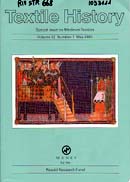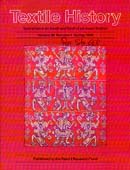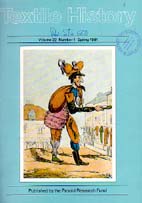Textile History 
Westbury. Pasold Research Fund, London School of Economics and Political Sciences
Semestrale
ISSN: 0040-4969
Conservata in: Università degli Studi di Firenze, Biblioteca di Scienze Sociali
Punto di servizio: Economia; Riv. str. 0668
Consistenza: a. 22, 1991, 1-
Lacune: a. 30, 1999, 2
[ 2030-2021 ] [ 2020-2011 ] [ 2010-2001 ] [ 2000-1991 ]

ARTICLES
Harald Deceulaer, Entrepreneurs in the Guilds: Ready-to-wear
clothing and subcontracting in late sixteenth and early seventeenth-century
Antwerp, p. 133
Paul H Rem, Restoration of the State Bed acquired by Het Loo
Palace, p. 150
Winifred Aldrich, Taylors’ cutting manuals and the Growing
Provision of Popular Clothing 1770-1870, p. 163
Andy Bielenberg, British competition and the vicissitudes
of the Irish wollen industry: 1785-1923, p. 202
Ian Mortimer, Joseph Melling, British government policies
for the regulation of Anthrax infection and the wool textiles
industries 1880-1939, p. 222
Book reviews, p. 237
Pasold research fund, p. 244
ARTICLES
David Brown, “Persons of infamous character”: the
textile pedlars and the role of peddling in industrialization, p. 1
Richard M. Candee, British framework knitters in New England:
technology transfer and machine knitting in America 1820-1900, p. 27
David M. Higgins, Competition, conflict and compromise: the
lancashire weaving industry during the inter-war years, p. 54
Sue Bowden, Paul Turner, Real wage rigidities and the bargaining
process: cotton spinning in the inter-war years, p. 77
J. I. Greaves, “Visible Hands “and the rationalization
of the British cotton industry 1925-1932, p. 102
Book reviews, p. 123
Pasold research fund, p. 129

Contributors, p. 3
ARTICLES
Steven Cohen, The earliest indian textile?, p. 5
Erna Wandl, Painted textiles in a Buddhist temple, p. 16
Deborah Swallow, The India museum and the British-Indian textile
trade in the late nineteenth century, p. 29
Marie-Louise Nabholz-Kartaschoff, The same – Yet not the same.
Similarities and differences in some textile techniques and textile
products from India and Bali, p. 46
Susan Conway, Bihar quilting and North-East thai weaving:
a comparative study of status, p. 69
Traude Gavin, Ruth Barnes, Iban prestige textiles and the
trade in Indian cloth: inspiration and perception, p. 81
Jenny Balfour-Paul, Indigo in South and South-East Asia, p. 98
OBITUARY
Lisa Monnas, Hero Granger-Taylor, Donald King (1920-1998)
an appreciation, p. 113
Book reviews, p. 116
Pasold research fund, p. 129
Contributors, p. 2
ARTICLES
David Brett, The menagement of colour: the kashmir Shawi in
a nineteenth-century debate, p. 123
Maria Hayward, Repositories of splendour: Hency VIII’s wardrobes
of the robes and beds, p. 134
Martha C. Halpern, Germantown goods: a survey of the textile
industry in Germantown, Philadelphia, p. 157
Cally Blackman, Handknitting in Britain from 1908 to 1939:
the work of Marjorie Tillotson, p. 177
Charlotte A. Jirousek, The end of the silk road: implications
of the decline of Turkish Sericulture, p. 201
CONFERENCE
Santina M. Levey, Linen in Europe, Irish linen centre and
Lisburn Museum, Northen Ireland, p. 226
Book reviews, p. 230
Short reviews, p. 237
Contributors, p. 3
ARTICLES
Jon Stobart, Textile industries in North-West England in the
early eighteenth century: a geographical approach, p. 3
Lesley Ellis Miller, Manufactures and the man: a reassessment
of the place of Jacques-Charles Dutilieu in the silk industry
of eighteenth-century Lyon, p. 19
Gillian Cookson, The mechanization of yorkshire card-Making, p. 41
Richard Candee, Domestic industry in the factory age: Anglo-american
development of the “family “knitting machine, p. 62
Dominique Cardon, Textile research: an unsuspected mine on
information on some eighteenth-century European textile products
and colour fashion, p. 93
EXHIBITIONS
John Williams, Nick Dixon, Gaby Porter, Fibres, Fabric and
fashion: a new gallery about textiles and Manchester’s textile
industry, p. 103
Pasold research fund, p. 108
Book reviews, p. 109
Short reviews, p. 117
Contributors, p. 118
ARTICLES
Nicholas Mander, Painted cloths: history, craftsmen and techniques,
p. 119
Fiona Kerlogue, The early English textile trade in South East
Asia: the East India company factory and the textile trade in
Jambi, Sumatra, 1615-1682, p. 149
Vanessa Habib, Scotch carpets in the eighteenth and early
nineteenth centuries, p. 161
Nicholas Thornton, Enigmatic variations: the features of British
smorks, p. 176
Sylvia Hogarth, Goldlace to Girthwebs – the evolution of a
trade in York, p. 185
Patrick O’Brien, The micro foundations of macro invention:
the case of the Reverend Edmund Cartwright, p. 201
Steve Onyeiwu, The modern textile industry in Nigeria: History,
Structural change, and recent developments, p. 234
Pasold research fund, p. 250
Book reviews, p. 253
Contributors, p. 2
Andrew Godley, Introduction: the development of the clothing
industry: technology and fashion, p. 3
ARTICLES
Stanley Chapman, I. & R. Morley: Colossus of the hosiery
trade and industry 1799-1965, p. 11
Christina Fowler, Robert Mansbridge, a rural tailor and his
customers, 1811-1815, p. 29
Anne J. Kershen, Morris Cohen and the origins of the women’s
wholesale clothing industry in the East End, p. 39
Katrina Honeyman, Gender divisions and industrial divide:
the case of the Leeds clothing tradem 1850-1970, p. 47
Andrew Godley, Comparative labour productivity in the British
and American clothing industries, 1850-1950, p. 67
The Japanese clothing industry after world war tho and the
emergence of the Gifu prefecture as a main production centre,
p. 81
Ian M. Taplin, Struggling to compete: post-war changes in
the US clothing industry, p. 90
Notes and queries, p. 105
Book reviews, p. 106
Short reviews, p. 111
Contributors, p. 126
Negley Harte, Professor Donald Coleman: an appreciation,
p. 127
ARTICLES
Carlo Marco Belfanti, Fashion and innovation: the origins
of the Italian hosiery industry in the sixteenth and seventeenth
centuries, p. 132
Clive D. Edwards, Floorcloth and linoleum: aspects of the
history of oil-coated materials for floors, p. 148
Agnes M. M. Lyons, The textile fabrics of India and Huddersfield
cloth industry, p. 172
J. Hemingway, Jacob Allison (1795-1868), Carpet manufacturer
of Bernard Castle and Cotherstone, p. 195
D. M. Higgins, G. Tweedale, The trade marks question and the
lancashire cotton textile industry, 1840-1914, p. 207
EXIBITION REPORT
Peter Preston, William Morris at the V. & A., p. 229
Notes and queries, p. 236
Book reviews, p. 237
Short reviews, p. 242
Contributors, p. 2
Editorial, p. 3
ARTICLES
Elisabeth Coatsworth, Maria Fitzgerald, Kevin Leahy, Gale Owen-Crocker,
Anglo-Saxon textiles from Cleatham, Humberside, p. 5
Gillian Cookson, Millwrights Clockmakers and the origins of
textile machine-making in Yorkshire, p. 43
Andrew Godley, Singer in Britain: the diffusion of sewing
machine technology and its impact on the clothing industry in
the U.K., 1860-1905, p. 59
J. S. Toms, Integration, Innovation and the progress of a
family cotton enterprise: Fielden Bros. Ltd., 1889-1914, p. 77
D. Montegut, Indictor, A. & J. Simmerfield, Technical
Examination of metal threads in some Indonesian textiles of West
Sumatra, p. 101
Notes and queries, p. 115
Book reviews, p. 119
Contributors, p. 128
ARTICLES
Patricia Wardle, The King’s Embroiderer: Edmund Harrison (1590-1667).
Part II. His work, p. 139
Michael Stratton, Barrie Trinder, The foundation of a textile
community: Sir Robert Peel at Fazeley, p. 185
Pamela Sharpe, “Cheapness and economy”: Manufacturing
and retailing ready-made clothing in London and Essex 1830-1850, p. 203
Domingos Giroletti, The growth of the Brazilian textile industry
and the transfer of technology, p. 215
Stuart Thompstone, Russian imperialism and the commercialization
of the central Asian cotton trade, p. 233
Book reviews, p. 259
Short reviews, p. 265
Contributors, p. 2
ARTICLES
M. L. Ryder, Fleece Grading and wool sorting, p. 3
Verity Wilson, Early textiles from central Asia: the Stein
Loan Collection, p. 23
Angela Sheng, The origin of chinese tapestry weave: a new
hypothesis, p. 53
Eugene C. Burt, Bark-cloth in East Africa, p. 75
Anthony J. Cooke, Cotton and the clearances – the development
of spinningdale 1791-1806, p. 89
David J. Jeremy, Transatlantic industrial espionage in the
early nineteenth century, p. 95
Book reviews, p. 123
Short reviews, p. 133
Contributors, p. 128
ARTICLES
John Styles, Clothing the North: the supply of non-élite
clothing in the eighteenth-century North of England, p. 139
Colin Heywood, Cotton hosiery in Troyes c. 1860-1914: a case
study in French industrialization, p. 167
Dong-Woon Kim, From a family partnership to a corporate company:
J. & P. Coats, thread manifactures, p. 185
Michael French, Co-ordinating manufacturing and marketing:
the role of the selling agent in US textiles, p. 227
Philip Scranton, The transition from custom to ready-to-wear
clothing in Philadelphia 1890-1930, p. 243
Book reviews, p. 275
Short reviews, p. 282
Contributors, p. 2
ARTICLES
Lisa Monnas, Opus Anglicanum and renaissance velvet: the Whalley
Abbey Vestments, p. 3
Patricia Wardle, The King’s Embroiderer: Edmund Harrison (1589-90-1667).
Part I. The man and his milieu, p. 29
Claudio Zanier, Current historical research into silk and
silk industry in Italy, p. 61
Roberto Tolaini, An Italian silk firm on the international
market: the scotis of Pescia (1815-1860), p. 79
REVIEW ARTICLE
Barrie Trinder, The archaeology of mills, p. 115
Book reviews, p. 121
Short reviews, p. 132
Special issue on STRATEGIES OF THE DECLINING LANCASHIRE TEXTILE
INDUSTRY
Guest Editor David J. Jeremy
Contributors, p. 126
Editorial, p. 127
ARTICLES
J. S. Toms, The profitability of the first Lancashire Merger:
the case of Horrocks, Crewdson & Co. Ltd, 1887-1905, p. 129
D. A. Farnie, The marketing Strategies of Platt Bros &
Co. Ltd of Oldham, 1906-1940, p. 147
David J. Jeremy, Survival strategies in Lancashire textiles:
Bleachers’ association Ltd to Whitecroft plc, 1900-1980s, p. 163
D. M. Higgins, Re-equipment as a strategy for survival in
the Lancashire spinning industry, c. 1945 – c. 1960, p. 211
John A. Blackburn, The British cotton textile industry since
world war II: the search for a strategy, p. 235
Contributors, p. 2
Editorial, p. 3
ARTICLES
Stanley Chapman, The innovating entrepreneurs in the British
ready-made clothing industry, p. 5
Sarah Levitt, From Mrs Bloomer to the Bloomer, p. 27
Amy de la Haye, The dissemination of design from haute couture
to fashionable ready-to-wear during the 1920s, p. 39
Elisabeth Lissenberg, Prisoners’ clothing in the Netherlands, p. 49
Judith Schuyf, “Trousers with flies!! “The clothing
and subculture of lesbians, p. 61
Carin Schnitger, Women’s dress reform in the Netherlands, p. 75
Lu Ann Jones, Sunae Park, From feed bags to fashion, p. 91
Frans L. Jansen, Distribution of ready-made clothing in the
twentieth century in the Netherlands, p. 105
Book reviews, p. 117
Short reviews, p. 122
Contributors, p. 138
ARTICLES
Albert Tanner, The cotton industry of Eastern Switzerland,
1750-1914, p. 139
Anne Wanner, The sample collections of machine embroidery
of Eastern Switzerland in the St Gallen textile museum, p. 165
José M. Lopes Cordeiro, The Royal silk twisting mill
of Chacim (Portugal), p. 177
Barrie Trinder, Ditherington flax mill – A re-evaluation, p. 189
Mark Watson, Bradford Works, Aberdeen: evidence for the earliest
iron-framed flax mills, p. 225
Roger Hoden, The architet in the Lancashire cotton industry,
1850-1914: the example of Stott & Sons, p. 243
Book reviews, p. 259
Short reviews, p. 267
Contributors, p. 3
ARTICLES
M. L. Ryder, Thea Gabra-Sanders and others, Textiles from
fast castle Berwickshire, Scotland, p. 5
David L. Wykes, The origins and development of the Leicestershire
Hosiery trade, p. 23
Jayne Shrimpton, Dressing for a tropical climate: the role
of native fabrics in fashionable dress in early colonial India, p. 55
Stanley Chapman, Vanners in the English silk industry, p. 71
Elisha P. Renne, The decline of women’s weaving among the
Nort-east Yoruba, p. 87
REVIEW ARTICLE
John A. Blackburn reviews John Singleton’s Lancashire on the
Scrapheap, p. 97
DOCUMENT AND SOURCES
Gwen Davies, Stockings prepared for laying out and burial
held by museums in the United Kingdom, p. 103
Norman Scarfe, Richard Wilson, Norwich’s textile industry
in 1784, p. 113
Book reviews, p. 121
Short reviews, p. 133
FABRIC AND FASHIONS
Studies in the economic and social history of dress
Edited by B. Harte
Foreword, p. 150
Contributors, p. 151
ARTICLES
David Corner, The tyranny of fashion: the case of the felt-hatting
trade in the late seventeenth and eighteenth centuries, p. 153
Sarah Levitt, Cheap mass-produced men’s clothing in the nineteenth
and early twentieth centuries, p. 179
Ursula Priestley, The marketing of norwich stuffs, c. 1660-1730, p. 193
Anne Buck, Buyng clothes in Bedfordshire: customers and tradesmen,
1700-1800, p. 211
Kay Staniland, Clothing provision and the great wardrobe in
the mid-thirteenth century, p. 239
Anne F. Sutton, Order and fashion in clothes: the King, his
household, and the city of London at the end of the fifteenth
century, p. 253
B. Harte, The economics of clothing in the late seventeenth
century, p. 277
Lorna Weatherill, Consumer Behaviour, Textiles and dress in
the late seventeenth and early eighteenth centuries, p. 297
Beverly Lemire, “A good stock of cloathes”: the
changing market for cotton clothing in Britain, 1750-1800, p. 311
Aileen Ribeiro, Fashion in the eighteenth century: some anglo-french
comparisons, p. 329
D. E. Allen, Fashion as a social process, p. 347

Contributors, p. 2
ARTICLES
Avigail Sheffer, Amalia Tidhar, The textiles from the “En-Boqeq
excavation in Israel, p. 3
Irena Turnau, The main centres of national fashion in eastern
Europe from the sixteenth to the eighteenth centuries, p. 47
Beverly Lemire, Pedding fashion: Salesman, Pawnbrokers, Taylors,
Thieves and the second-hand clothes trade in England, c. 1700-1800, p. 67
Stephen C. Wallwork, A review of the statistic of the growth
of the British hosiery industry, 1844-1984, p. 83
George J. Murfet, The Henry Ashwell legagy, p. 105
R. S. Nutter, Stone-Platt: An R & D Failure, p. 121
Book reviews, p. 137
Short reviews, p. 145
